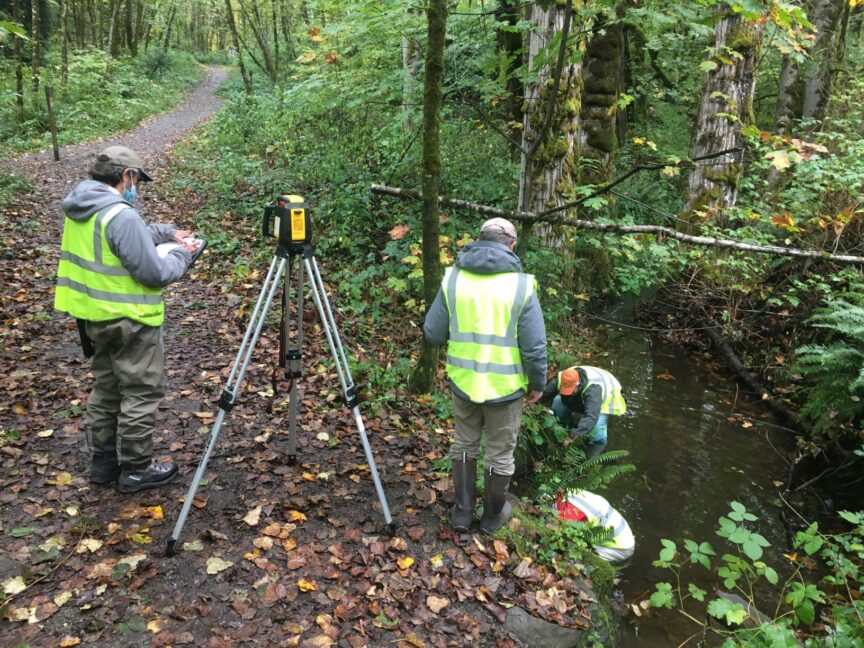
Image: Steve Miller/WCTU
This is a guest post from Washington Council of Trout Unlimited’s Advocacy Committee member Steve Miller.
The Washington Council of Trout Unlimited has launched a new and exciting initiative to improve opportunities to recover our iconic but threatened wild steelhead and salmon.
Background
The U.S. Supreme Court has ruled that the State of Washington must fund the replacement of culverts on state land that represent a significant barrier to migrating fish. Although the ruling applies only to state lands, all landowners, including federal, county, and private, are now aware that problem barriers should be replaced.
Culverts, like all infrastructure, eventually degrade over time. In many cases they’ve quietly become fish barriers no one knows much about. There are as many as 40,000 culverts around Washington. While not all are equally harmful to fish, there is an immediate need to assess and prioritize culverts regarding their actual or potential impacts on fish.
T.U.’s ‘B.A.T. Team’ is born
Around the country, improving fish passage by repairing or replacing problem culverts is one of TU’s specialties. The new mandate in Washington provides a great opportunity to get involved with this requirement. Our first steps have been to recruit volunteers to join our BAT (Barrier Assessment Team) to do the assessment work and to purchase necessary survey equipment.
The Washington Department of Fish and Wildlife is a partner in this project and provided TU with access to their fish passage barrier website. WDFW also provided a trainer for TU staff and volunteers in how to do the assessments. Meanwhile, TU’s Washington Council moved to secure the necessary funding.

Image: Steve Miller/WCTU
For this type of work, professional quality surveying equipment is a must. Rotating lasers mounted on tripods, electronic rangefinders, GPS units, and other items needed to be ordered and put into kits the volunteers could check out.
As you can guess, this equipment was expensive. Through generous grants from the Folley Foundation, the Clovis Foundation, the Horizons Foundation and many TU donors, TU was able to purchase five complete assessment ‘kits’ which, with the skills of our trained volunteers, generate and report high quality technical data.
After the data has been collected—and there’s lots of it—it’s recorded in the WDFW site and reviewed. The data include information on the type and shape of the culvert, type of culvert material (concrete, steel, etc.), water surface drop, span and rise and slope. Based on these data, a decision flow chart is used to assign a ‘passability’ rating for each culvert.
Ratings can range from no blockage, to partially or mostly blocked, to completely blocked. The ratings are then used to inform the process WDFW uses for prioritizing the culverts to be replaced. The decision process is based on a grid developed by the State Barrier Removal Board and includes criteria like number of fish species involved (or potentially involved), amount of quality spawning and rearing habitat opened up, cost of the work, and other variables.
Given the large number of culverts in Washington, there’s no shortage of this work that needs to be done. At present, many culverts aren’t yet listed, much less properly assessed.
To date, we’ve conducted three classes and 20 volunteers have been trained, certified and provided with equipment. Future classes will be offered in other parts of the state as we grow and expand, beginning in Ellensburg next spring. These trainings feature two parts: 4 hours of virtual classroom-style training to familiarize everyone with some basic concepts, working definitions and filling out the required paperwork, and, a full day of field training where everyone is given a chance to conduct actual assessments using our equipment.

Image: Luke Kelly/TU
Beginning next spring we will post information about upcoming classes, locations, dates, etc. Volunteers will be accepted on a first-come, first-served basis.
To facilitate the training, we’ve also created a section of the Washington TU website dedicated to our BAT project. The material on this site provides all the information and resources a BAT volunteer needs to capably assess most culverts.
Next Steps
Because this program is new, it’s a work-in-progress. We will continue to modify and improve our approach and practices as we gain more experience. Eventually, we want to be doing this work in most of the priority watersheds for salmon and steelhead in the state.
Beginning this spring, we’ll also be offering an additional class and certification focusing on assessing wood and log jams in rivers. These log jams, both natural and man-made, play important roles in saving our fish. Stay tuned for more details.
For additional information please contact Nick Ulacia, our Volunteer BAT Program Coordinator, at nicholas@washingtontu.org


